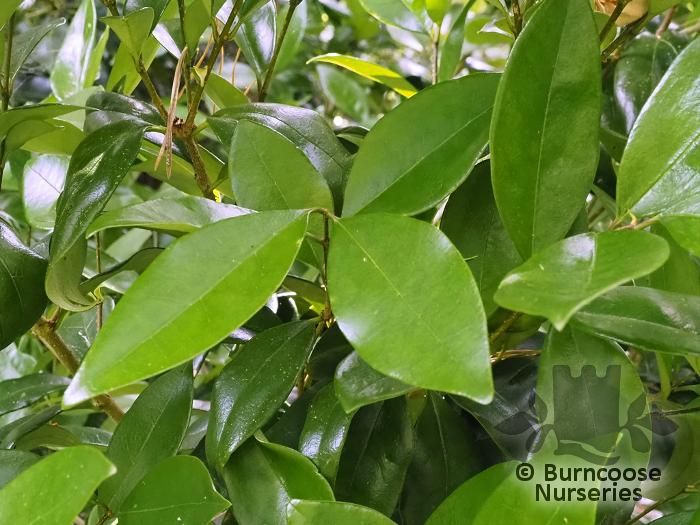Plants by mail order since 1984, over 4100 plants online today
Nursery & Gardens open: Mon - Sat 8:30 - 17:00 & Sun 10:00 - 16:00
Pop up café: open weather dependent
- Shop Now
- Burncoose Specialities
- This Month
- Offers & Promotions
- RHS Chelsea Flower Show 2024
- 40 years at Burncoose
- Engage With Us
- Information, Help & Advice
- About Us & Our Services
- Terms & Conditions
- Log In / Register
PRUNUS lusitanica subsp. azorica
Large, red-stalked, glossy dark green leaves
-
EvergreenOvate to elliptic leaves to 12cm (5in) long
-
 White
White -
 Height15m (49ft)
Height15m (49ft) -
 Spread15m (49ft)
Spread15m (49ft) -
HedgeIdeal for hedging
-
Tall ShrubDense, bushy shrub with broader, thicker leaves and fewer flowers than lusitanica. Flowers to 1.5cm (½ib) across in slender ascending, spreading or pendent racemes to 10cm (4in) long
-
 Half hardy - unheated greenhouse / mild winterHardy in coastal and relatively mild parts of the UK except in severe winters and a risk from sudden (early) frosts. May be hardy elsewhere with wall shelter or good micro-climate. Likely to be damaged or killed in cold winters. Plant can withstand temperatures down to -5°C (23°F)
Half hardy - unheated greenhouse / mild winterHardy in coastal and relatively mild parts of the UK except in severe winters and a risk from sudden (early) frosts. May be hardy elsewhere with wall shelter or good micro-climate. Likely to be damaged or killed in cold winters. Plant can withstand temperatures down to -5°C (23°F) -
 Full sun
Full sun -
 Partial shade
Partial shade
PRUNUS lusitanica subsp. azorica
-
Additional Features
 Good to knowWildlife plant. Flowers for bees and other insects. Berries for birds
Good to knowWildlife plant. Flowers for bees and other insects. Berries for birds Pests & DiseasesGenerally trouble-free
Pests & DiseasesGenerally trouble-free Place of originAzoresResistant to honey fungusThese plants have little or few problems with honey fungus.
Place of originAzoresResistant to honey fungusThese plants have little or few problems with honey fungus. -
Flower ShapeCup-shaped
-
HardinessFrost hardy (down to -5)
-
Leaf margin
 Serrulate
Serrulate(see photos above) -
Leaf shape
 Elliptic
Elliptic(see photos above)  Ovate
Ovate(see photos above) -
Pruning group
 Pruning group 5Suitable for: Evergreen shrubs that require minimal pruning.
Pruning group 5Suitable for: Evergreen shrubs that require minimal pruning.
Action: Trim or lightly cut back shoots that spoil symmetry. Deadhead regularly.
When: Annually after flowering.
-
Scented PlantsScented flowers
-
Seasonal InterestAutumnSpringSummerWinter
-
Soil ConditionsFertile moist well-drained soilModerately fertile
-
Toxic - Category C
 Harmful if eatenPeople and pets, i.e. cats, dogs, rabbits, rodents
Harmful if eatenPeople and pets, i.e. cats, dogs, rabbits, rodents -
Wildlife
 Bee friendly
Bee friendly Bird friendlyRabbit Resistant
Bird friendlyRabbit Resistant
Jan
Feb
Mar
Apr
May
Jun
Jul
Aug
Sep
Oct
Nov
Dec
|
15m (49ft)
|

|

|
|
15m (49ft) |
Useful extras...

Fertilisers & Feeds - Vitax
Q4 Pelleted Fertiliser
A useful fertiliser suitable for use on a wide variety of plants. Q4 provides all the nutrients and trace elements essential for vigorous growth, abundant flowering and ripening of fruit.
3 options from £6.00

Fertilisers & Feeds - Empathy
Afterplant - Grow Your Own
AFTER PLANT GROW YOUR OWN seaweed is ready to use liquid concentrate that was specially formulated be used on all edible plants.
Only £8.00

Fertilisers & Feeds - Empathy
Afterplant - Tomatoes
AFTER PLANT TOMATO FEED Liquid Concentrate with Bio stimulant is a high potash liquid concentrate containing seaweed extract, plant derived amino acids and other nutrients specifically formulated to benefit tomatoes and greenhouse plants.
Only £8.00

Fertilisers & Feeds - Empathy
Rootgrow mycorrhizal fungi
Recommended by the RHS. Contains Rootgrow™ mycorrhizal fungi. Suitable for all trees and shrubs (except rhododendrons, azaleas, heathers, cranberries and blueberries)
3 options from £3.00

Fertilisers & Feeds - Empathy
Rootgrow Ericoid mycorrhizal fungi
This specially adapted Rootgrow™ mycorrhizal fungi will boost the growth of acid-loving plants like rhododendrons, azaleas, heathers and blueberries.
It contains ericoid and arbuscular mycorrhizal fungi, which are found in poor acidic soils where ericaceous plants naturally grow.
Only £7.50

Fertilisers & Feeds - Empathy
All-purpose Seaweed Stimulant
All-purpose organic concentrated seaweed feed that is a ready to use, derived from sustainable harvested kelp, that can be used on all outdoor and indoor plants, except acid loving plants.
Perfect used in conjunction with Rootgrow™.
Only £7.50





















